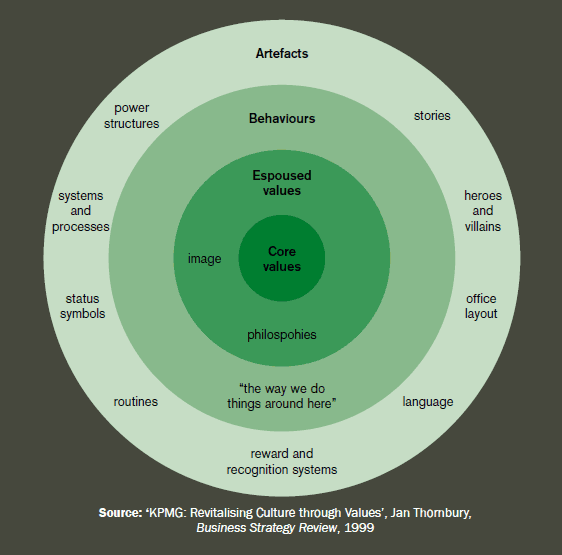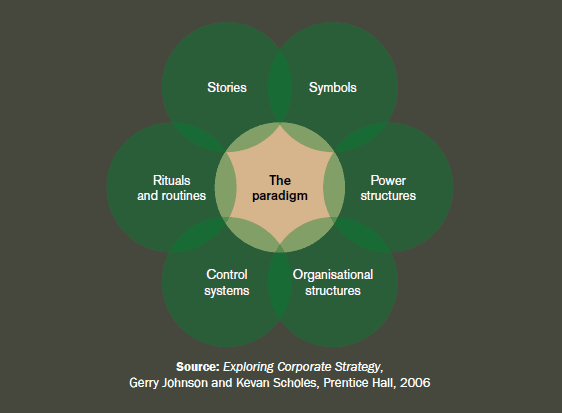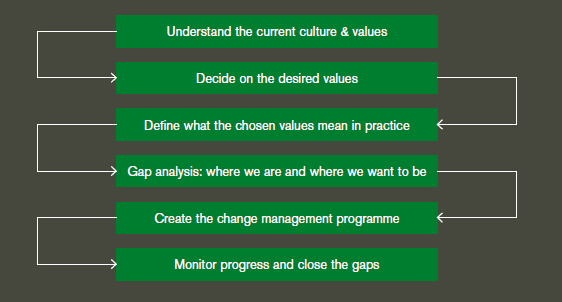In law firms of all sizes, managing partners are keen to position their firms as having a clear set of guiding principles by which they conduct business, engage with teams and serve clients.
However, there is often an underlying misconception that a values-led approach is altruistic or,
worse still, simply a public relations exercise. Nothing could be further from the truth.
When developed properly and deployed effectively, a values programme is a powerful management
tool for changing behaviours, aligning people across a diverse business with a common sense of
purpose and creating a competitive advantage.
This article will consider the meaning of values, how a law firm can understand its current culture and values, and the ways in which a values-led approach can be hardwired into the firm’s daily operations. It is in this final aspect that many find most challenging – how to convert a set of guiding principles into a series of hard-edged management tools.
Introducing change
Engagement of people across the firm is crucial in the change management process which
accompanies any successful values programme. Above all, the leadership group must be seen
to be fully involved and committed. The partners must walk the talk if they are to have any
expectation that others will too. Moreover, the partnership as a whole must be prepared to
confront and address any behaviour at partner level which is seen to fly in the face of the firm’s espoused values.
Definition of the firm’s values, the priority that they should be given and a common language
with which to describe them (and the behaviours that support them) needs to be developed,
communicated well and unambiguously understood throughout the firm – and then seen to be
acted upon.
To be truly effective, values need to shape management processes and systems. They need to be
taken into account in deciding how people are rewarded, recruited, developed and promoted.
There are, of course, a number of challenges which need to be overcome in any values programme.
These include:
- cynicism and defensiveness;
- partners who are not necessarily comfortable in the role of manager or motivator;
- a range of cultures and affinities that need to be brought together – in a firm that is multi-sited, operates in practice group silos or has been formed by merger, such cultural differences are deep-rooted and difficult to move;
- values programmes will often seek to leverage the client base for the benefit of the whole firm, but if the firm’s recognition and reward system does not reinforce this, historic protectionism around clients may persist;
- a desire to operate in a more collaborative way may be limited by a lack of systems or experience of how to do so, requiring additional investment in software and training;
- processes which do not support the firm’s values will need to be changed;
- inconsistency of approach around the firm, leading to a range of different client experiences; and
- no clear line of sight between values and career progression.
To be successful, the programme must not just define the desired values but also take the firm through the change processes necessary to make them real and overcome the hurdles which will
inevitably exist.
A well-structured approach provides firms with many opportunities. By aligning behaviours and
ensuring that values form a framework within which decisionmaking and management can be
conducted, firms will be better able to manage their client relationships, deliver their strategic
objectives and ensure high levels of staff loyalty.
Defining values and culture
Businesses which have demonstrable track records of success tend to have a small number of
deeply-held beliefs or values, according to leading research by Jim Collins and Jerry Porras. They
found that visionary organisations tend to have between three and six fundamental and deeplyhelp
values.1
Core values are important from a number of perspectives. They represent a succinct way of
communicating what the firm holds dear and, as such, influence behaviour – in effect they provide
a moral compass for the business.
Values can be particularly effective in helping firms to be responsive to a fastchanging competitive
environment, since they provide a clear framework within which decisions can be made. Values
allow tough decisions to be made more easily and allow decision-making to be decentralised,
thus helping leaders to be more proactive.
Jan Thornbury has suggested that culture may be analysed using a framework that considers four
layers, as illustrated in Figure 1. Successful organisations demonstrate strong alignment across
the layers, meaning that each reinforces the other.

|
| Figure 1: Four layers of culture
|
These layers may be categorised as follows.
- Artefacts are the most visible manifestations of deeper values and culture, and the means by which the firm recognises and rewards it people.
- Behaviours represent a deeper manifestation of culture and may be thought of as ‘the way we do things around here’.
- Espoused values are the things which the firm articulates in terms of its philosophies and the image that it projects to the market.
- Core values are the deepest-held beliefs about the firm, which should not to be compromised for financial gain or short-term expediency.

|
| Figure 2: The cultural web
|
Another framework to consider is Johnson & Scholes’ cultural web (see Figure 2), which considers
the ways in which the paradigm is manifested through a number of lenses. These are the takenfor-
granted assumptions about the way in which the firm operates and the behaviours which are
encouraged, accepted, discouraged or barred.
When used together, they can provide strong insights into the underlying value systems of the
firm and provide visible and highly symbolic factors on which the change agent can focus in
galvanising cultural change.
The power of values, together with the cultural norms that they manifest, can often be clearly
seem when a firm attempts to impose hard systems which are in conflict with its underlying
values, in the absence of any wider culture-shift agenda.
While the management rulebook may set out how the firm should operate, in a professional
service culture, it is the firm’s underlying values that determine how it does operate in practice.
Managing partners who have tried to impose a particular approach have often discovered the power of values and culture to their cost.
Impact of values
There are various ways in which values may impact on the running and success of a law firm.
The values and beliefs which underpin a law firm’s culture are often what differentiate one firm
from another, according to research by Oonagh Mary Harpur.2 When partners and staff receive
inconsistent messages about what senior management value, the firm can quickly become
insecure and confused. So, for each option, senior managers should consider what values would
be communicated by that outcome.
Changing working practices
One of the most powerful ways in which values can be used as a positive force is in the changing
of working practices. By providing a framework for acceptable behaviour, a values programme
provides a clear framework and strong leverage to a change process.
Set within a larger change management framework, values provide an important reference point,
allowing the management team to communicate clearly and succinctly.
Developing the brand
For many law firms, the challenge in brand management lies at the interface between the overall
client experience and the expectation that has been created by the firm’s marketing efforts.
The ways in which an alignment between brand promise, brand experience and core values can
be achieved include:
- making values visible to the client base;
- putting initiatives in place which encourage close interaction between the firm and clients that
reinforce these values; and
- engaging clients in assessing how well the business ‘walks the talk’ of its cultural promises.
Figure 3 adapts Hugh Davidson’s idea of the brand iceberg to illustrate the interplay of values in
a law firm and the role that values play in driving the overall client experience.3
Assessing mergers
It is important to understand how values and culture may differ between potential merger partners
or drive postmerger integration.
While short-term success may be framed in the necessary achievement of structural goals –
merging IT systems, combining offices, developing new management structures and creating a
consistent set of role specifications – the reality is that the longer term sustainability of any merger is rooted in cultural alignment.

|
| Figure 3: The firm’s brand iceberg
|
An evaluation of the values and cultural drivers of each of the merging parties should be
undertaken as early as possible in the process. This will help with an assessment of true business
compatibility.
There are many of examples of firms which have excellent compatibility on paper (i.e. complementary
practice areas, excellent combined client bases with few conflicts, and lots of synergies and
opportunities to reduce the combined cost base), but are culturally at odds. Such a union is
unlikely to progress well.
Understanding antecedent cultures and setting out a clear set of values for the new entity is a key
part of a successful union.
Defining firm values
There is a logical process which should be followed in defining firm values (see Figure 4).

|
| Figure 4: Defining values
|
| Making values tangible in practice
|
One of the challenges faced by many senior management teams is how to make core values tangible in practice. This will often be achieved by ensuring that management and decision
making is made and communicated within the context of a values framework.
So, for example, a firm that has ‘teamwork’ as a core value might place the demonstration of
behaviours which show teamwork as a central plank of its performance management systems.
It could use the ‘teamwork’ value to guide the way in which it develops its client relationships
and to put collaborative approaches high on its agenda for cross-group working.
All of these will have a direct line of sight back to the core value. Ultimately, the core value
should sit behind and inform the firm’s approach at every level – emotionally, intellectually and
pragmatically.
To assist people in envisaging how behaviours are linked to values, it can often be helpful to
draw up a simple table showing how certain actions are supportive (i.e. what good looks like)
and how others may be contrary (i.e. what bad looks like).
The creation of these schedules can, in itself, be an important group exercise to promote engagement
with the values programme across the firm. By asking small groups to consider how
a particular value can be evidenced in practice, understanding is enhanced and buy-in to the
firm’s overall objectives increased.
Some professional service firms have gone so far as to publish such behaviours on their websites
and other external stakeholder communication channels. For example, BDO (which was an early adopter of a values driven approach) devotes the ‘values’ section of its website to a schedule of behaviours which would be expected in order for the firm to live up its commitment to each of its four core values.
|
1. Understand current culture and values
Using the models outlined in this article, the physical manifestations of current culture can be
assessed.
A deeper cultural analysis can then be achieved through a series of face-to-face structured
interviews with partners and staff using a series of open questions. These interviews have the
objective of gaining individual perspectives on the core aspects of the firm’s culture.
It would be then be useful, both for reasons of statistical verification and engagement of people
across the firm, to test the assessment more widely across the firm via a web survey tool. This
analysis can quickly identify and evaluate any differences in values across various constituencies
in a firm – which can be particularly helpful in a geographically diverse business or one which has
just merged.
Of course, in a merger situation, such a cultural assessment should ideally be carried out premerger
to evaluate compatibility and to assist in post-merger integration planning.
2. Decide on the desired culture and values
A key question often asked at this juncture is, who decides on the firm’s desired values going
forward? Given the participative nature of a values programme and the need to engage people
across the firm in behavioural change, there can be a misconception that future values should be
decided by polling ‘the people’.
The firm’s values should be decided by the partnership, as this is the group which has to provide
direction to the firm and coalesce behind any change.
Some people within the firm may not subscribe to the values programme – in which case they
have a clear option to seek employment elsewhere, perhaps in a firm that offers a culture more
aligned to their own belief system.
The partnership, however, must reach a consensus (and be seen to do so) if any programme is
to succeed in the longer term.
3. Define what the values mean in practice
The next stage is to create a framework to define what each value means in practical terms from
a number of different perspectives (see box: ‘Making values tangible in practice’).
The framework can then be used to conduct a gap-analysis assessment of the changes that
need to be made to current behaviours and practices, which systems or processes may need to
be introduced and how success may be measured.
4. Put in place the necessary change programme
Having reached a clear picture of the desired values, the current state and the ways in which
success will be measured, it then falls to the management team to implement the change
programme.
Ongoing reviews should be conducted to assess progress and ensure the management team
can track how closely the values programme is driving behavioural changes within the firm.
Endnotes
1. See Built to Last, 3rd ed., Jim Collins and Jerry Porras, Harper Paperbacks, 2002
2. See ‘Decision Making Conditioned by Values’, Oonagh Mary Harpur, Long Range Planning,
Vol. 32, Issue 2, 1999
3. See Even More Offensive Marketing, Hugh Davidson, Penguin Books, 1997




